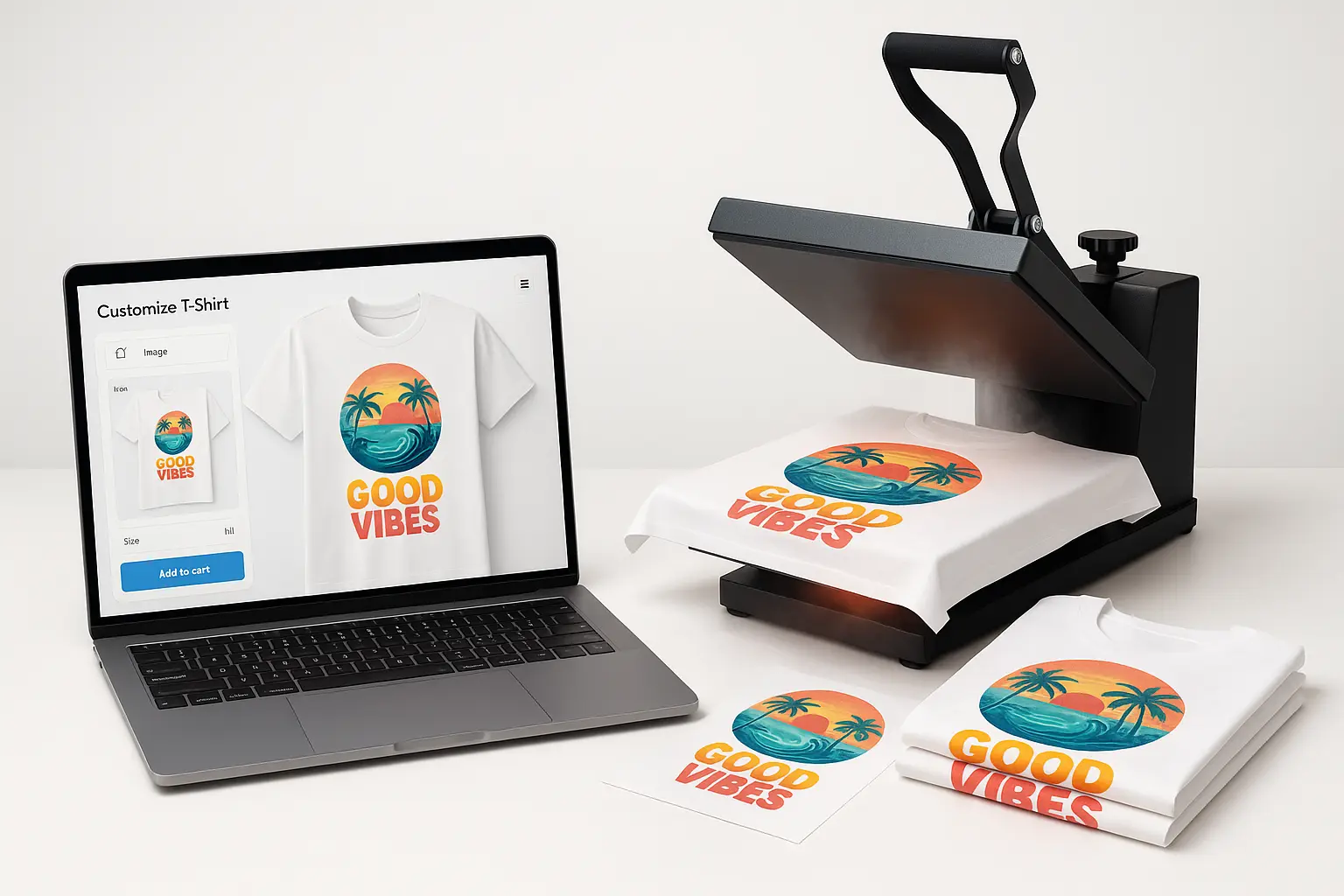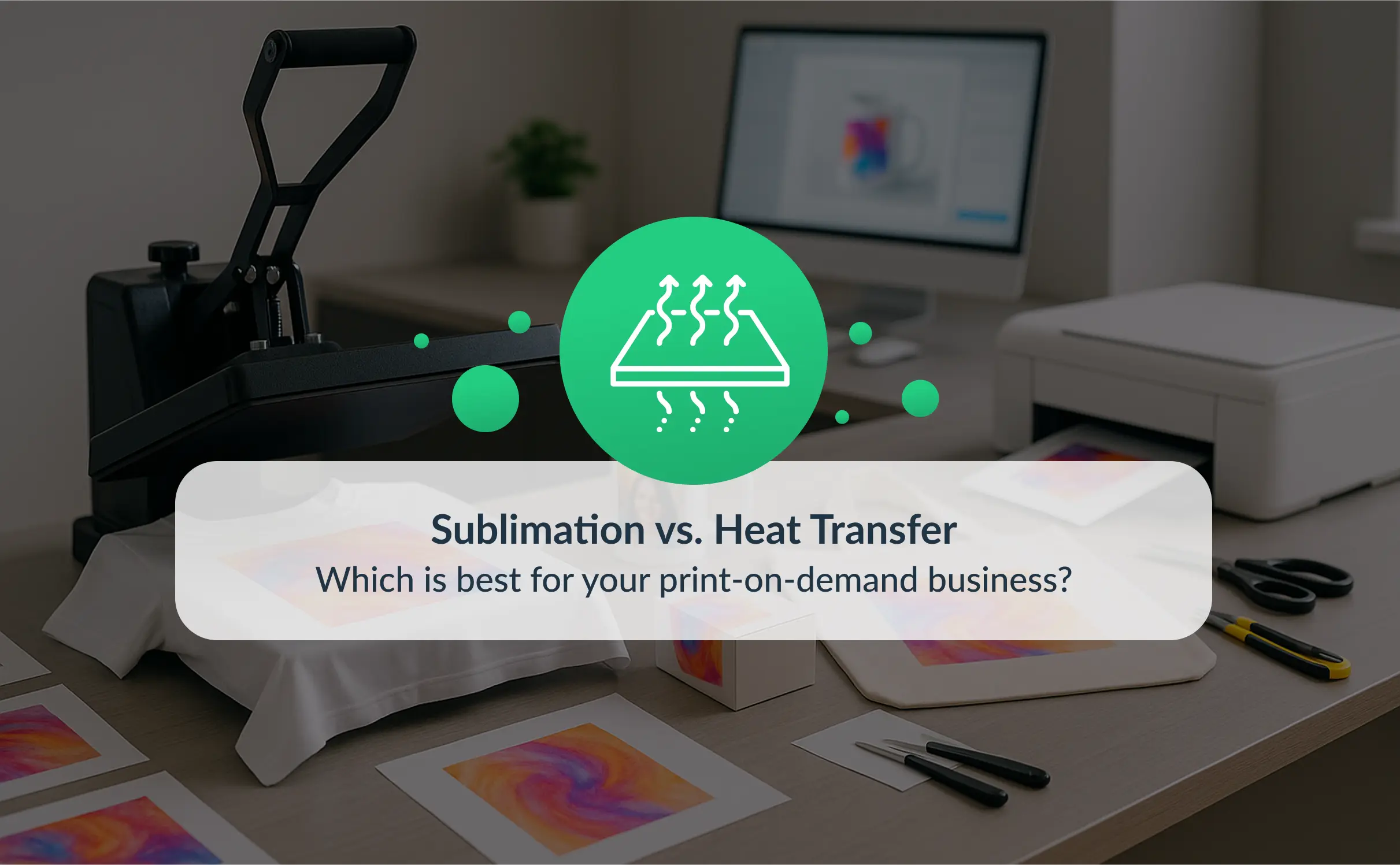A mid-sized photo product business is scaling fast. Order volumes are up, SKUs are diversifying, and customers expect seamless personalization across everything from mugs to metal prints. But with growth comes a bigger question: which production method can keep up without sacrificing quality or margin?
When evaluating sublimation vs heat transfer, most guides focus on surface-level differences: color vibrancy, textile compatibility, or startup costs. What’s less commonly discussed (but arguably more important for e-commerce businesses at scale) is how these technologies integrate with digital workflows, support automation, and impact long-term operational flexibility. We’ll guide you through both processes, highlight strategic trade-offs, and help you analyze what’s right for your business model.
What is Sublimation Printing?
Sublimation printing is commonly used for high-quality, full-color transfers – especially when working with polyester-based materials. It uses a process where dye turns into gas without becoming liquid, allowing it to bond with the surface of a product at the molecular level.
In the personalized photo products industry, it’s widely adopted for items like custom apparel, mugs, phone cases, and photo panels – products where color fidelity and durability are essential. Sublimation is particularly compatible with on-demand workflows, where each order may be unique, but also assumes synthetic substrates and a tightly controlled print environment. While there are ways to print on blended fabrics or non-poly materials, they often require coatings or compromise quality.
How Sublimation Works
The process begins with a digital design, printed onto sublimation paper using sublimation ink. This paper is then placed against the substrate – typically a polyester fabric or coated surface – and pressed at around 400°F. Heat transforms the dye into gas, which penetrates the surface and becomes embedded in the material.
Unlike surface-level printing, the result is a chemical bond within the substrate. That’s why sublimation prints don’t peel or crack and offer excellent clarity and color integrity – making them a great fit for premium product lines.
Advantages of Sublimation Printing
- Durability: Designs become part of the product, not just printed on top – ideal for wear-and-tear applications.
- Color vibrancy: Sublimation excels at producing vivid, high-resolution imagery faithful to the original design.
- Workflow efficiency: The digital-first process supports full automation. When integrated with APIs, product editors, or order management systems, it minimizes human input and accelerates output.
A growing number of businesses are integrating sublimation workflows directly into their ecommerce tech stack – for example, linking online product designers to automated print queues. This direct-to-printer flow can dramatically cut lead times for personalized orders, especially when templates and layouts are dynamically generated. Just note: this level of automation assumes tight middleware integration or RIP software between the frontend and printer.
Sublimation also plays well with AI-powered tools – from layout optimization to upsell recommendations. Its digital-native format aligns naturally with platforms focused on print on demand for personalized photo products, where every second and click counts.
Disadvantages of Sublimation Printing
- Substrate limitations: Sublimation works best with polyester or poly-coated materials. For other substrates, you’ll need pre-treatment or coating, which can impact finish or durability.
- Equipment setup: Specialized printers, heat presses, and paper add to upfront costs – and ongoing training is a must.
- Environmental concerns: While sublimation produces less physical waste than methods using vinyl, it still consumes significant energy and depends on synthetic base materials – not a perfect match for every sustainability strategy.

What is Heat Transfer Printing?
Heat transfer refers to methods that apply printed designs to substrates using heat and pressure. Unlike sublimation, the design remains on the surface of the material – typically as a film or ink layer.
It’s widely used in apparel (especially cotton), promo goods, and hard substrates like tote bags and wood. Because of its low entry cost and compatibility with various surfaces, it’s favored by startups, Etsy sellers, and product teams testing new SKUs.
One modern variant gaining traction is Direct-to-Film (DTF) printing. DTF prints the design onto film and uses a powdered adhesive that melts during heat pressing. This added glue layer allows detailed, vibrant transfers on cotton and other difficult fabrics – expanding the heat transfer use case beyond traditional limits.
How Heat Transfer Works
The design is printed onto heat transfer paper using inkjet, laser, or solvent-based systems. Then the printed paper is placed on the substrate, and a heat press applies pressure to activate adhesive and fix the design to the product.
Different transfer methods – vinyl, plastisol, DTF – produce different textures and levels of durability. That’s why understanding sublimation paper vs heat transfer paper is so important: the chemistry and mechanics behind each significantly impact the result.
Advantages of Heat Transfer Printing
- Material range: Works on cotton, wood, leather, and other non-coated materials – which gives you broader SKU flexibility.
- Lower cost of entry: Heat transfer setups are budget-friendly, especially for short runs or prototyping.
- Speed to launch: It’s easy to get started and test ideas – ideal for seasonal collections or early-stage businesses.
For brands experimenting with product-market fit, heat transfer provides a low-risk entry. That’s why it’s often part of a two-speed model: flexible for new items, scalable when combined with other print methods. Read more in our guide to growing your print business, which highlights how hybrid workflows support both agility and operational discipline.
Disadvantages of Heat Transfer Printing
But versatility comes with some caveats:
- Durability: Transfers can crack or peel, especially after repeated washing – though newer technologies like DTF and hybrid inks improve this.
- Texture: Because designs sit on the surface, some customers may perceive a “sticker-like” feel – although premium films minimize this effect.
- Sustainability trade-offs: Many films and adhesives include plastics or solvents. While some water-based options exist, not all are production-ready at scale.
Sublimation vs Heat Transfer: Key Differences
Let’s break down the practical and strategic implications of sublimation vs heat transfer:
- Output quality: Sublimation is seamless and bonded; heat transfer is layered – although DTF narrows that gap.
- Material fit: Sublimation prefers coated polyester. Heat transfer supports a broader mix, including natural fibers.
- Scalability: Sublimation works well with automation and SaaS workflows. Heat transfer vs sublimation gets trickier at scale due to setup variability.
- Startup costs: Sublimation demands higher upfront spend; heat transfer is lighter to launch.
- Sustainability: Sublimation creates minimal physical waste but relies on synthetics. Heat transfer uses more consumables and plastics – though innovation is ongoing.
Deciding between sublimation paper vs heat transfer paper isn’t just a print-quality question. It’s about workflow design. We’ve seen B2B sellers consolidate product lines around shared substrate types to streamline their operations – especially in multi-surface catalogs. This makes switching between workflows easier and keeps personalization flowing.
For a full dive into related production styles, check our guide on Different Printing Methods for the Web-to-Print Industry.
Which is Better for Your Business?
Here’s the thing: there’s no single winner in the sublimation printing vs heat transfer debate.
If you’re building fast – launching new SKUs weekly, customizing on natural materials, or operating with minimal infrastructure – heat transfer gives you a lot of room to move.
But if you’re optimizing for scale, integrating storefronts with print queues, and offering premium, durable output – sublimation is hard to beat.
The real answer lives in your backend. Businesses deciding between heat transfer vs sublimation often don’t choose based on color specs – they choose based on what’s feasible with their workflows, team, and platform.
More and more photo product companies are going hybrid. Think: sublimation for panels and apparel, heat transfer for merchandise. The secret isn’t choosing one or the other – it’s unifying operations around both. When routed through a single SaaS stack, you can automate intelligently and scale without bottlenecks.
Ready to Choose or Mix Methods?
Whichever you choose, don’t treat print method decisions as isolated. They directly influence your ability to deliver at scale, automate intelligently, and personalize meaningfully – especially in a cloud-native e-commerce stack.
Want to explore real-world setups? Book a Printbox demo to see both methods working within a single unified flow.
What’s the main difference between sublimation and heat transfer printing?
Sublimation infuses dye into polyester materials for permanent, high-quality prints, while heat transfer applies a design layer on top of various surfaces like cotton or wood using heat and pressure.
Which printing method is better for scaling a personalized print business?
Sublimation is often better for scaling due to its compatibility with SaaS automation and faster, more reliable order workflows—ideal for businesses prioritizing efficiency and premium quality.
Can I use sublimation printing on cotton or wood products?
No, sublimation requires polyester or specially coated materials—it's not suitable for untreated cotton, wood, or other porous natural surfaces.
Is heat transfer printing more affordable for startups?
Yes, heat transfer printing has a lower upfront cost and offers more flexibility for small batches or testing new products, making it ideal for startups or Etsy sellers.
Which method offers better durability and print quality?
Sublimation offers superior durability and color vibrancy because the dye becomes part of the material, making it resistant to cracking, fading, or peeling.
Can I use both sublimation and heat transfer in one print setup?
Yes, many businesses adopt a hybrid model—using sublimation for polyester-based products and heat transfer for items like cotton bags or wooden signs—to match product needs while streamlining operations.




